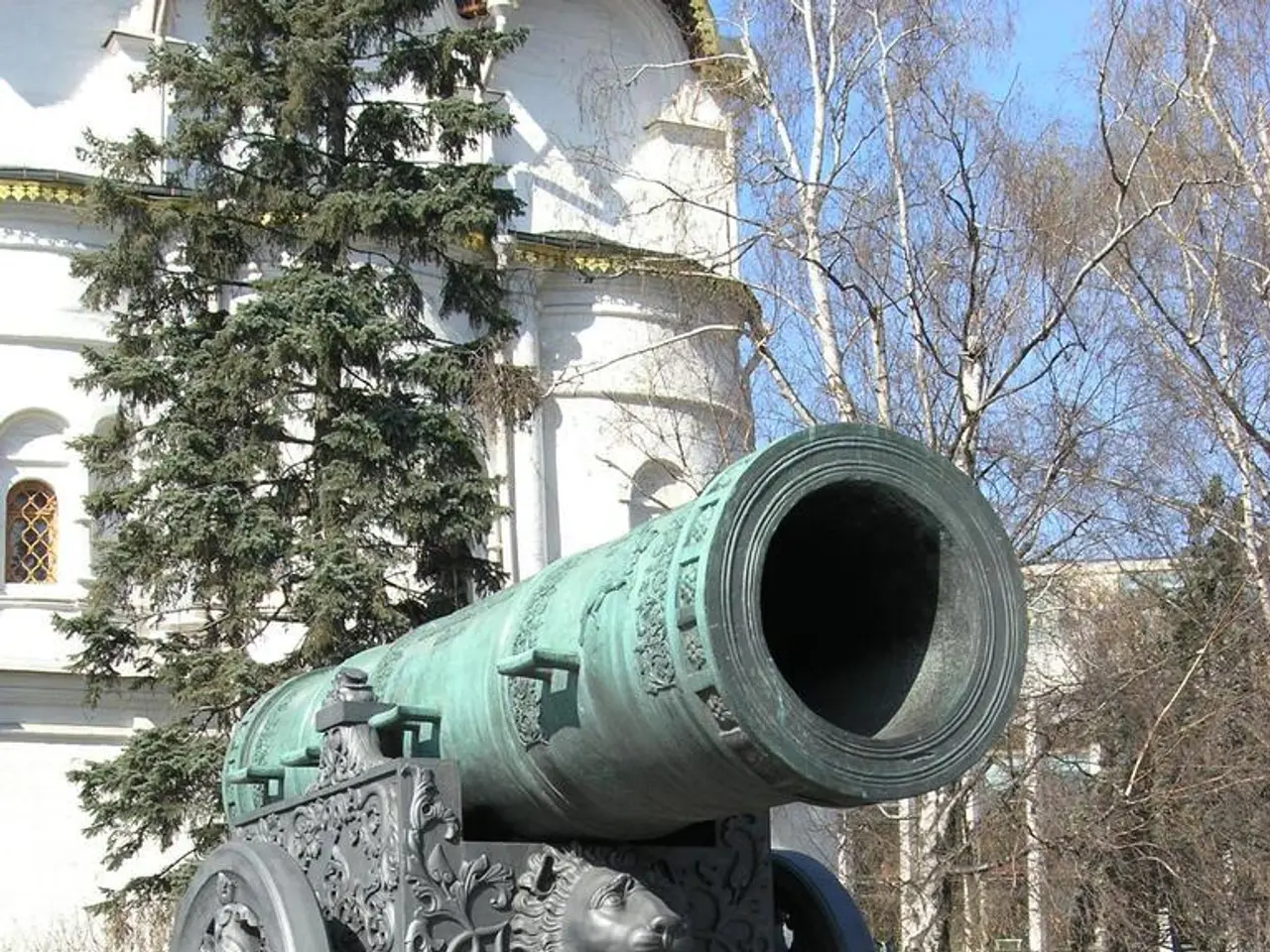Engineers and managers in Moscow are switching from jackets to rings as a new fashion trend or potential symbol.
Swapping Shields for Swords: A Thrilling Journey into Ancient Rus'
Step into the dense forest, where tradition, history, and martial spirit converge. I'm in search of the "Heritage of the Ancestors" festival, a celebration drenched in the spirit of ancient Russian culture. My grumbles echo through the leaves,
- Where are these historical reenactors? They promised a dive into ancient themes, but all I see are Belarusian partisans making their appearance.
Finally, I stumble upon the venue. The strange quietude draws me in.
Photo: Dmitry POLUKHIN
BUHURT TOURNAMENT
The day kicks off with a Buhrt. Two teams clash onto the field, their muscles straining beneath their armor. A crowd gathers, anticipation high. The tournament master does his part, fanning the flames and proclaiming the beginning of the battle.
A whirlwind of clashing shields, the ringing of swords, and the occasional shout fills the air. The spectacle lasts but a mere 20 seconds.
Why so quick, you ask? The rules are simple: a strike with any weapon, be it sword or spear, sends your enemy sprawling. The only defense is agility, skillful maneuvering, or pinpoint precision.
Despite the tension, the strikes appear almost comical. It's either a gentle tap on the enemy's shield or a missed swing that barely brushes their armor. Defeated warriors retreat, waiting for their comrades to finish their game of sword tag.
As the tales of old tell us, a well-aimed arrow can not only vanquish the enemy but also win the heart of a fair maiden.
Photo: Andrei ABRAMOV
- You want us to impale each other? Ancient battles were brutal, blood-soaked affairs. One or two strikes, and it was lights out. So forget the romanticized "they fought for three days and three nights" - participants retort to my complaints.
AN ELEGANT, COSTLY PASTIME
This event attracts enthusiasts eager to relive the age of Kievan Rus' and the centuries preceding it - roughly from the 8th to the 11th century.
- I'm a Byzantine merchant, - smiles blacksmith Tikhon, and he tells me about his outfit.
He's wearing a dalmatic - a tunic-like garment. If it gets chilly, he can add another layer or two.
A former engineer-ecologist, Tikhon found his calling as a blacksmith in this reenactment community, his business thriving with the sale of 800 sets of armor per year. His clientele includes not only fellow reenactors but also filmmakers. The most affordable set, complete with a sword and armor, costs 50,000 rubles.
A CLAY JUG AND ANCIENT SPEECH
I venture into a reconstruction camp, mead in hand. It's a spirited gathering, and I receive a warm welcome. However, my polite "Excuse me..." is met with puzzled frowns.
- We don't use "you" here, they tell me. "You" was used to address enemies - "I go to you."
My mead is swiftly taken from my hands - I feared it stolen! It turns out they hurried to pour it from the plastic bottle into a clay jug - a nod to historical accuracy during the festivals.
This festival spans three exhilarating days, complete with tents, outdoor cooking, and only the bare minimum of modern conveniences. All participants dress in historically accurate attire, drawing from a mix of Scandinavian, Slavic, and Byzantine influences. The only concession to modernity is a shower tent tucked away discreetly.
- Hungry for sustenance? Here's a bite of our ancient menu:
- gałganek: a linen-wrapped dough, boiled for an hour;
- meatballs, also boiled;
- dessert, boiled turnip with raisins and apples.
Reenactors take their research seriously, sourcing materials from historical monographs and archaeological sites. If there's a nail, it's not from a modern hardware store, but an authentic, hand-hammered replica. Only the blacksmiths lament the modern steel, preferring the more challenging material their ancient counterparts would have used.
REVISITING ANCIENT RUSSIA
Reenactors address each other by nicknames, as was the custom in ancient times. During my time at the festival, I met Pshenka, Kryva, Zhira, Shchur, Viking... Yet, they communicate in a decidedly contemporary manner.
- "Let us, dear brother Tikhon, forsake our beds and entertain the crowd with deeds of valor," they don't say.
Two popular eras among Russian reenactors are the "Napoleonic" era and Ancient Rus'. The former offers vividly colored uniforms, while the latter caters to a growing fascination with one's roots.
However, a slippery slope looms, as history can easily become twisted with pseudoscientific theories, leaning towards the esoteric. Oleg, a reenactor and client manager, points out the complexities. Additionally, they often find themselves grouped with cosplayers and enthusiasts of fantasy literature, a source of annoyance and misunderstanding.
But why do all this?
- To pause the relentless march of time, to delve into the experiences of life a thousand years ago, to remember the core values they held - respect for nature, large families, helping strangers, and their neighborly communities. It's a simpler time, one we could learn from, reenactors share. Not the extreme lifestyles of harems or patriarchal societies, but the pursuit of community and the preservation of timeless values.
Roman, another reenactor, sums it up best:
- It all happened so quickly. Modern life offers us new phones every year, yet their clothes lasted a decade. I want to slow down, reconstruct the rhythm of their lives, discover the principles they lived by - principles that could enrich our lives today.
- In the midst of this historical reenactment, I find myself yearning for a glimpse into the lifestyle of ancient Rus'. The fusion of fashion-and-beauty, food-and-drink, home-and-garden, and travel elements would certainly add an intriguing twist to the immersive experience.
- A well-crafted dalmatic worn by the blacksmith, Tikhon, brings a touch of fashion-and-beauty to the otherwise grim scene of historical reenactment. His commitment to authenticity makes one wonder about the potential for merging this pastime with the world of high fashion.
- The festival's emphasis on authentic cooking stirs my curiosity about the food habits of ancient Rus'. A fusion of dishes, combining elements of Scandinavian, Slavic, and Byzantine cuisine, would make for an exciting food-and-drink adventure. Perhaps even modern chefs could take inspiration from these ancient recipes to reinvent some iconic dishes.





